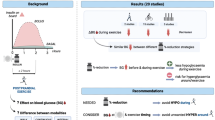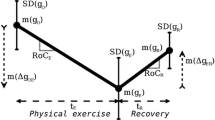Abstract
Background
Regulation of postprandial hyperglycemia is a major concern for individuals with type 2 diabetes. Exercise can reduce postprandial hyperglycemia by increasing contraction-mediated glucose uptake. However, there is no consensus with which to develop guidelines for optimal postprandial exercise timing and prescription.
Objective
The current systematic review was conducted to consolidate the literature surrounding the effects of postprandial exercise on glucose regulation in individuals with type 2 diabetes.
Methods
Electronic databases were searched on 17 February 2017. Inclusion criteria were: (1) trial was a randomized crossover trial; (2) subjects were diagnosed with type 2 diabetes; (3) a standardized meal was given; (4) exercise was initiated within three hours of the meal; (5) subjects were not treated with insulin.
Results
Twelve studies met the inclusion criteria, involving 135 participants (108 males, 20 females, seven unknown). The included studies varied greatly in their timing, duration, intensity, modality, and glucose measures. Postprandial aerobic exercise (11 studies) decreased short-term glucose area under the curve by 3.4–26.6% and 24-h prevalence of hyperglycemia by 11.9–65%. Resistance exercise (two studies) decreased the short-term glucose area under the curve by 30% and 24-h prevalence of hyperglycemia by 35%.
Conclusion
Postprandial exercise may be an effective way to improve glucose control in individuals with type 2 diabetes. The most consistent benefits were seen in long-duration (≥ 45 min), moderate-intensity aerobic exercise. Resistance training also appears to be an effective modality. We recommend that individuals with type 2 diabetes focus on increasing energy expenditure after the largest meal of the day. More research is needed in this area to confirm the results of this systematic review and to provide clinicians with specific exercise recommendations.

Similar content being viewed by others
References
Cavalot F, Pagliarino A, Valle M, Di Martino L, Bonomo K, Massucco P, et al. Postprandial blood glucose predicts cardiovascular events and all-cause mortality in type 2 diabetes in a 14-year follow-up: lessons from the San Luigi Gonzaga Diabetes Study. Diabetes Care. 2011;34(10):2237–43.
Bacchi E, Negri C, Trombetta M, Zanolin ME, Lanza M, Bonora E, et al. Differences in the acute effects of aerobic and resistance exercise in subjects with type 2 diabetes: Results from the RAED2 Randomized Trial. Earnest CP, editor. PLoS One. 2012;7(12):e49937.
Huang S, Czech MP. The GLUT-4 glucose transporter. Cell Metab [Internet]. 2007 [cited 2017 May 22];5(4):237–52. http://www.sciencedirect.com/science/article/pii/S1550413107000678.
Colberg SR, Sigal RJ, Fernhall B, Regensteiner JG, Blissmer BJ, Rubin RR, et al. Exercise and type 2 diabetes: The American College of Sports Medicine and the American Diabetes Association: joint position statement. Diabetes Care. 2010;33(12):e147–67.
Moher D, Shamseer L, Clarke M, Ghersi D, Liberati A, Petticrew M, et al. Preferred reporting items for systematic review and meta-analysis protocols (PRISMA-P) 2015 statement. Syst Rev [Internet]. 2015;4(1):1. http://systematicreviewsjournal.biomedcentral.com/articles/10.1186/2046-4053-4-1.
Jadad AR, Moore RA, Carroll D, Jenkinson C, Reynolds DJ, Gavaghan DJ, et al. Assessing the quality of reports of randomized clinical trials: is blinding necessary? Control Clin Trials [Internet]. 1996[cited 2017 Aug 3];17(1):1–12. http://www.ncbi.nlm.nih.gov/pubmed/8721797.
Maher CG, Moseley AM, Sherrington C, Elkins MR, Herbert RD. A description of the trials, reviews, and practice guidelines indexed in the PEDro database. Phys Ther. 2008;88(9):1068–77.
Verhagen AP, de Vet HCW, de Bie RA, Kessels AGH, Boers M, Bouter LM, et al. The Delphi list: a criteria for quality assessment of randomized clinical trials for conducting systematic reviews developed by Delphi consensus. J Clin Epidemiol. 1998;51(98):1235–41.
Moher D, Schulz KF, Altman DG. The CONSORT statement: revised recommendations for improving the quality of reports of parallel-group randomised trials. Lancet [Internet]. 2001;357(9263):1191–4. http://www.sciencedirect.com/science/article/pii/S0140673600043373.
Van Rosendal SP, Osborne MA, Fassett RG, Coombes JS. Guidelines for glycerol use in hyperhydration and rehydration associated with exercise. Sports Med. 2010;40:113–39.
Haxhi J, Leto G, di Palumbo AS, Sbriccoli P, Guidetti L, Fantini C, et al. Exercise at lunchtime: effect on glycemic control and oxidative stress in middle-aged men with type 2 diabetes. Eur J Appl Physiol. 2016;116(3):573–82.
Larsen JJS, Dela F, Kjaer M, Galbo H. The effect of moderate exercise on postprandial glucose homeostasis in NIDDM patients. Diabetologia. 1997;40(4):447–53.
Larsen JJS, Dela F, Madsbad S, Galbo H. The effect of intense exercise on postprandial glucose homeostasis in type II diabetic patients. Diabetologia. 1999;42(11):1282–92.
Poirier P, Mawhinney S, Grondin L, Tremblay A, Broderick T, Cleroux J, et al. Prior meal enhances the plasma glucose lowering effect of exercise in type 2 diabetes. Med Sci Sport Exerc. 2001;33(8):1259–64.
van Dijk J-W, Venema M, van Mechelen W, Stehouwer CDA, Hartgens F, van Loon LJC. Effect of moderate-intensity exercise versus activities of daily living on 24-hour blood glucose homeostasis in male patients with type 2 diabetes. Diabetes Care [Internet]. 2013[cited 2017 Feb 12];36(11):3448–53. http://www.ncbi.nlm.nih.gov/pubmed/24041682.
van Dijk J-W, Manders RJF, Tummers K, Bonomi AG, Stehouwer CDA, Hartgens F, et al. Both resistance- and endurance-type exercise reduce the prevalence of hyperglycaemia in individuals with impaired glucose tolerance and in insulin-treated and non-insulin-treated type 2 diabetic patients. Diabetologia [Internet]. 2012 [cited 2017 Feb 12];55(5):1273–82. http://link.springer.com/10.1007/s00125-011-2380-5.
Colberg SR, Zarrabi L, Bennington L, Nakave A, Thomas Somma C, Swain DP, et al. Postprandial walking is better for lowering the glycemic effect of dinner than pre-dinner exercise in type 2 diabetic individuals. J Am Med Dir Assoc. 2009;10(6):394–7.
Gillen JB, Little JP, Punthakee Z, Tarnopolsky MA, Riddell MC, Gibala MJ. Acute high-intensity interval exercise reduces the postprandial glucose response and prevalence of hyperglycaemia in patients with type 2 diabetes. Diabetes Obes Metab. 2012;14(6):575–7.
Honda H, Igaki M, Hatanaka Y, Komatsu M, Tanaka S, Miki T, et al. Stair climbing/descending exercise for a short time decreases blood glucose levels after a meal in people with type 2 diabetes. BMJ Open Diabetes Res Care. 2016;4(1):e000232.
Takaishi T. Stair climbing/descending exercise-immediate effect against postprandial hyperglycemia in older people with type 2 diabetes mellitus. Ann Sport Med Res. 2015;2(3):1023.
Heden TD, Winn NC, Mari A, Booth FW, Rector RS, Thyfault JP, et al. Postdinner resistance exercise improves postprandial risk factors more effectively than predinner resistance exercise in patients with type 2 diabetes. J Appl Physiol. 2015;118(5):624–34.
Manders RJF, van Dijk J-WM, van Loon LJC. Low-intensity exercise reduces the prevalence of hyperglycemia in type 2 diabetes. Med Sci Sport Exerc [Internet]. 2010[cited 2017 Feb 12];42(2):219–25. http://content.wkhealth.com/linkback/openurl?sid=WKPTLP:landingpage&an=00005768-201002000-00001.
Tobin LWL, Kiens B, Galbo H. The effect of exercise on postprandial lipidemia in type 2 diabetic patients. Eur J Appl Physiol [Internet]. 2007[cited 2017 Feb 12];102(3):361–70. http://www.ncbi.nlm.nih.gov/pubmed/17952452.
Umpierrez GE, Isaacs SD, Bazargan N, You X, Thaler LM, Kitabchi AE. Hyperglycemia: an independent marker of in-hospital mortality in patients with undiagnosed diabetes. [cited 2017 May 27]. https://oup.silverchair-cdn.com/oup/backfile/Content_public/Journal/jcem/87/3/10.1210_jcem.87.3.8341/2/jcem0978.pdf.
Pistrosch F, Natali A, Hanefeld M. Is hyperglycemia a cardiovascular risk factor? Diabetes Care [Internet]. 2011 [cited 2017 May 27];34 Suppl 2(Suppl 2):S128–31. http://www.ncbi.nlm.nih.gov/pubmed/21525443.
Larsen JJS, Dela F, Kjaer M, Galbo H. The effect of moderate exercise on postprandial glucose homeostasis in NIDDM patients. Diabetologia. 1997;40:447–53.
Poirier P, Tremblay A, Catellier C, Tancrède G, Garneau C, Nadeau A. Impact of time interval from the last meal on glucose response to exercise in subjects with type 2 diabetes. J Clin Endocrinol Metab [Internet]. 2000[cited 2017 Feb 12];85(8):2860–4. http://press.endocrine.org/doi/10.1210/jcem.85.8.6760.
Høstmark AT, Ekeland GS, Beckstrøm AC, Meen HD. Postprandial light physical activity blunts the blood glucose increase. Prev Med (Baltim) [Internet]. 2006 [cited 2017 May 28];42(5):369–71. http://linkinghub.elsevier.com/retrieve/pii/S0091743505001623
Tappy L. Thermic effect of food and sympathetic nervous system activity in humans. Reprod Nutr Dev [Internet]. 1996 [cited 2017 May 28];36(4):391–7. http://www.ncbi.nlm.nih.gov/pubmed/8878356.
Haxhi J, Scotto di Palumbo A, Sacchetti M. Exercising for metabolic control: is timing important? Ann Nutr Metab. 2013;62(1):14–25.
Zoungas S, Chalmers J, Ninomiya T, Li Q, Cooper ME, Colagiuri S, et al. Association of HbA1c levels with vascular complications and death in patients with type 2 diabetes: evidence of glycaemic thresholds. Diabetologia [Internet]. 2012[cited 2017 Jul 11];55(3):636–43. http://www.ncbi.nlm.nih.gov/pubmed/22186981.
Laughlin MH. Physical activity-induced remodeling of vasculature in skeletal muscle: role in treatment of type 2 diabetes. J Appl Physiol. 2016;120(1):1–16.
Falck RS, Davis JC, Milosevic E, Liu-Ambrose T. How much will older adults exercise? A feasibility study of aerobic training combined with resistance training. Pilot Feasibility Stud [Internet]. 2017[cited 2017 Jun 2];3(1):2. http://www.ncbi.nlm.nih.gov/pubmed/28138396.
Hill EE, Zack E, Battaglini C, Viru M, Viru A, Hackney AC. Exercise and circulating cortisol levels: the intensity threshold effect. J Endocrinol Invest. 2008;31(7):587–91.
Hackney AC, Walz EA. Hormonal adaptation and the stress of exercise training: the role of glucocorticoids. 2013 [cited 2017 Apr 2];4(420):165–71. http://www.tss.awf.poznan.pl/files/Vol_4_Hackney_-_Walz.pdf
Tomiyama AJ, Mann T, Vinas D, Hunger JM, Dejager J, Taylor SE. Low calorie dieting increases cortisol. Psychosom Med [Internet]. 2010 [cited 2017 Jun 2];72(4):357–64. http://www.ncbi.nlm.nih.gov/pubmed/20368473
Colberg SR, Sigal RJ, Yardley JE, Riddell MC, Dunstan DW, Dempsey PC, et al. Physical activity/exercise and diabetes: a position statement of the American Diabetes Association. Diabetes Care [Internet]. 2016 [cited 2017 Dec 4];39(11):2065–79. http://care.diabetesjournals.org/content/39/11/2065.
Funding
No sources of funding were used to assist in the preparation of this article.
Author information
Authors and Affiliations
Corresponding author
Ethics declarations
Conflict of interest
Andrew Borror, Gabriel Zieff, Claudio Battaglini, and Lee Stoner declare that they have no conflicts of interest relevant to the content of this review.
Electronic supplementary material
Below is the link to the electronic supplementary material.
Rights and permissions
About this article
Cite this article
Borror, A., Zieff, G., Battaglini, C. et al. The Effects of Postprandial Exercise on Glucose Control in Individuals with Type 2 Diabetes: A Systematic Review. Sports Med 48, 1479–1491 (2018). https://doi.org/10.1007/s40279-018-0864-x
Published:
Issue Date:
DOI: https://doi.org/10.1007/s40279-018-0864-x




